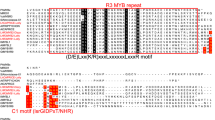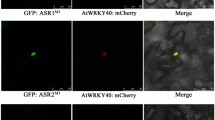Abstract
Anthocyanins are the predominant visible pigments in flowers of the Oriental hybrid lily (Lilium spp.). To understand the regulatory mechanisms of flower coloration in this hybrid lily, full-length cDNA of the R2R3-MYB gene, LhSorMYB12, was isolated from anthocyanin-accumulating tepals of the cultivar Sorbonne. The deduced amino acid sequence of LhSorMYB12 showed 85% (209/246) identity, including a gap of seven amino acids, with an amino acid sequence in LhMonMYB12 that regulates anthocyanin biosynthesis in the Asiatic hybrid lily. Transcripts of LhSorMYB12 accumulated in anthocyanin-accumulating tepals of three cultivars but not in white tepals of two other cultivars. The white-tepal cultivar Rialto showed LhMYB12 transcription in tepals, but the Rialto sequence contained amino acid replacements in the R2 repeat, resulting in reduced transcription of anthocyanin biosynthesis genes and in no pigmentation. Spatial and temporal transcription of LhSorMYB12 showed that transcription of LhMYB12 corresponded well with transcription of anthocyanin biosynthesis genes in tepal regions where anthocyanins accumulated and in anthocyanin spots on tepals. These results indicate that LhSorMYB12 definitely regulates anthocyanin biosynthesis and is responsible for the tepal color difference between Oriental hybrid lily cultivars.




Similar content being viewed by others
References
Abe H, Nakano M, Nakatsuka A, Nakayama M, Koshioka M, Yamagishi M (2002) Genetic analysis of floral anthocyanin pigmentation traits in Asiatic hybrid lily using molecular linkage maps. Theor Appl Genet 105:1175–1182
Asano Y (1989) Lilium L. In: Tsukamoto Y (ed) The grand dictionary of horticulture, vol 5. Syogakukan, Tokyo, pp 198–209 (in Japanese)
Comber HF (1949) A new classification of the genus Lilium. Lily Yearbook. R Hort Soc 13:85–105
Espley RV, Brendolise C, Chagné D, Kutty-Amma S, Green S, Volz R, Putterill J, Schouten HJ, Gardiner SE, Hellens RP, Allan AC (2009) Multiple repeats of a promoter segment causes transcription factor autoregulation in red apples. Plant Cell 21:168–183
Kanazawa A, O’Dell M, Hellens RP (2007) Epigenetic inactivation of chalcone synthase-A transgene transcription in petunia leads to a reversion of the post-transcriptional gene silencing phenotype. Plant Cell Physiol 48:638–647
Kimura M (1980) A simple method for estimating evolutionary rate of base substitutions through comparative studies of nucleotide sequences. J Mol Evol 16:111–120
Koes R, Verweij W, Quattrocchio F (2005) Flavonoids: a colorful model for the regulation and evolution of biochemical pathways. Trends Plant Sci 10:236–242
Lai YS, Yamagishi M (2010) cDNA cloning and expression profiles of genes concerned with anthocyanin biosynthesis in Asiatic hybrid lily. Hort Res (Japan) 9 (Supple 1):205
Leslie AC (1982) The international lily register, 3rd edn. The Royal Horticultural Society, London
Masuda K, Xu Z-J, Takahashi S, Ito A, Ono M, Nomura K, Inoue M (1997) Peripheral framework of carrot cell nucleus contains a novel protein predicted to exhibit a long α-helical domain. Exp Cell Res 232:173–181
Mol J, Grotewold E, Koes R (1998) How genes paint flowers and seeds. Trends Plant Sci 3:212–217
Morita Y, Saitoh M, Hoshino A, Nitasaka E, Iida S (2006) Isolation of cDNAs for R2R3-MYB, bHLH and WDR transcriptional regulators and identification of c and ca mutations conferring white flowers in the Japanese morning glory. Plant Cell Physiol 47:457–470
Nakatsuka A, Izumi Y, Yamagishi M (2003) Spatial and temporal expression of chalcone synthase and dihydroflavonol 4-reductase genes in the Asiatic hybrid lily. Plant Sci 165:759–767
Nakatsuka A, Yamagishi M, Nakano M, Tasakia K, Kobayashi N (2009) Light-induced expression of basic helix-loop-helix genes involved in anthocyanin biosynthesis in flowers and leaves of Asiatic hybrid lily. Sci Hort 121:84–91
Nørbæk R, Kondo T (1999) Anthocyanin from flowers of Lilium (Liliaceae). Phytochemistry 50:1181–1184
Saito R, Fukuta N, Ohmiya A, Itoh Y, Ozeki Y, Kuchitsu K, Nakayama M (2006) Regulation of anthocyanin biosynthesis involved in the formation of marginal picotee petals in Petunia. Plant Sci 170:828–834
Saitoh K, Onishi K, Mikami I, Thidar K, Sano Y (2004) Allelic diversification at the C (OsC1) locus of wild and cultivated rice: nucleotide changes associated with phenotypes. Genetics 168:997–1007
Saitou N, Nei N (1987) The neighbour-joining method: a new method for reconstructing phylogenetic trees. Mol Biol Evol 4:406–425
Schwinn KE, Davies KM (2004) Flavonoids. Annu Plant Rev 14:92–149
Shimizu M (1987) The lilies in Japan. Seibundo Shinkosha Publishing Co Ltd, Tokyo (in Japanese)
Smyth DR, Kongsuwan K, Wisudharomn S (1989) A survey of C-band patterns in chromosomes of Lilium (Liliaceae). Plant System Evol 163:53–69
Stracke R, Werber M, Weisshaar B (2001) The R2R3-MYB gene family in Arabidopsis thaliana. Curr Opin Plant Sci 4:447–456
Takos AM, Jaffé FW, Jacob SR, Bogs J, Robinson SP, Walker AR (2006) Light-induced expression of a MYB gene regulates anthocyanin biosynthesis in red apples. Plant Physiol 142:1216–1232
Tateishi N, Ozaki Y, Okubo H (2010) White marginal picotee formation in the petals of Camellia japonica ‘Tamanoura’. J Jpn Soc Hort Sci 79:207–214
Thompson JD, Higgins DG, Gibson TJ (1994) Improved sensitivity of profile searches through the use of sequence weights and gap excision. Comput Appl Biosci 10:19–29
Yamagishi M, Kishimoto S, Nakayama M (2010a) Carotenoid composition and changes in expression of carotenoid biosynthetic genes in tepals of Asiatic hybrid lily. Plant Breed 129:100–107
Yamagishi M, Shimoyamada Y, Nakatsuka T, Masuda K (2010b) Two R2R3-MYB genes, homologues of petunia AN2, regulate anthocyanin biosyntheses in flower tepals, tepal spots and leaves of Asiatic hybrid lily. Plant Cell Physiol 51:463–474
Zimmermann IM, Heim MA, Weisshaar B, Uhrig JF (2004) Comprehensive identification of Arabidopsis thaliana MYB transcription factors interacting with R/B-like BHLH proteins. Plant J 40:22–34
Acknowledgments
This work was supported by a Grant-In-Aid for Scientific Research (No. 17380015), the Ministry of Education, Culture, Sports, Science and Technology of Japan.
Author information
Authors and Affiliations
Corresponding author
Additional information
The nucleotide sequences reported in this paper have been submitted to DDBJ under accession numbers AB558584 and AB558585.
Electronic supplementary material
Below is the link to the electronic supplementary material.
Rights and permissions
About this article
Cite this article
Yamagishi, M. Oriental hybrid lily Sorbonne homologue of LhMYB12 regulates anthocyanin biosyntheses in flower tepals and tepal spots. Mol Breeding 28, 381–389 (2011). https://doi.org/10.1007/s11032-010-9490-5
Received:
Accepted:
Published:
Issue Date:
DOI: https://doi.org/10.1007/s11032-010-9490-5




